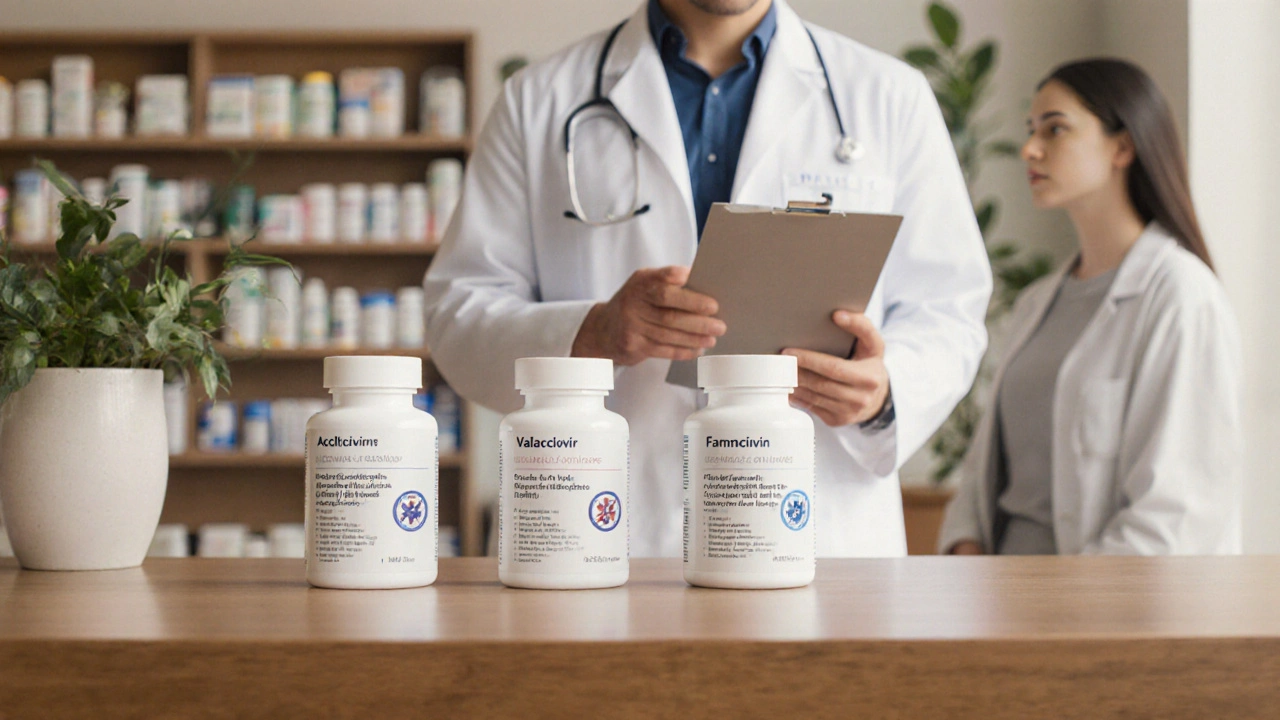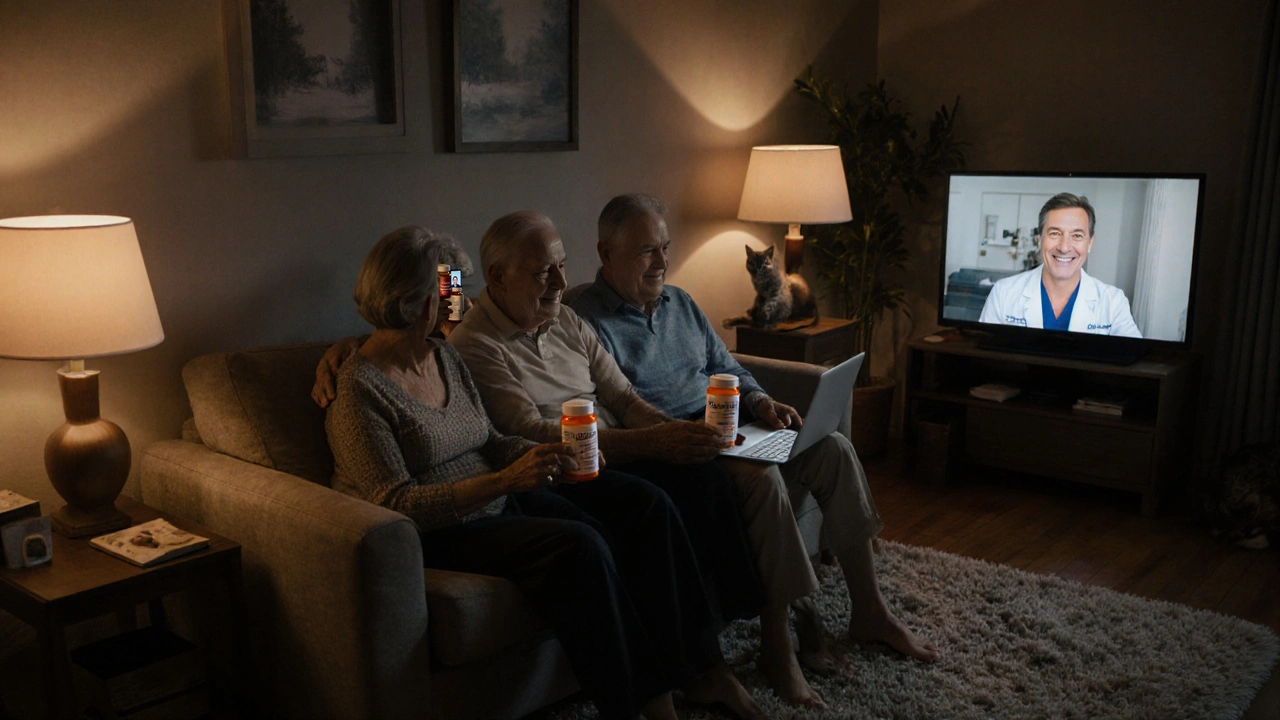
Antiviral Drug Comparison Tool
Select a drug to compare its characteristics:
Quick takeaways
- Aciclovir is the oldest, cheapest oral antiviral for HSV and VZV, but its bioavailability is low (15‑30%).
- Valacyclovir and famciclovir are pro‑drugs that boost blood levels, allowing fewer daily doses.
- Penciclovir is only available as a topical cream; it works well for cold sores but not for systemic infections.
- Ganciclovir targets CMV and requires IV administration - a niche beyond the usual herpes simplex regimen.
- Resistance is rare in immunocompetent patients; it spikes in transplant recipients or AIDS patients.
Aciclovir is a nucleoside‑analogue antiviral medication that blocks the viral DNA polymerase of herpes‑family viruses. It was first approved in 1982 and has become the foundation of outpatient herpes treatment. Aciclovir works by being phosphorylated inside infected cells, turning into a triphosphate that competes with deoxyguanosine triphosphate, halting viral replication. Its charm lies in the low cost (often underAUD5 per 30‑day course) and a solid safety record - nausea, headache, and mild renal effects are the most common side‑effects.
How Aciclovir compares to other oral antivirals
When clinicians choose a drug, they weigh three core factors: how much of the drug reaches the bloodstream (bioavailability), how easy the dosing schedule is, and how well the drug covers the target virus. Below is a side‑by‑side view of the four most frequently prescribed agents.
| Drug | Bioavailability | Typical Dose (adult) | Half‑life | Key Indications |
|---|---|---|---|---|
| Aciclovir | 15‑30% | 400mg five times daily (HSV) or 800mg five times daily (VZV) | ~2.5h | Genital herpes, shingles, neonatal HSV prophylaxis |
| Valacyclovir | 55‑70% (as pro‑drug) | 1g twice daily (HSV) or 1g three times daily (VZV) | ~2.5h (valacyclovir converts to aciclovir) | Genital herpes, shingles, herpes labialis, suppressive therapy |
| Famciclovir | 77% (as pro‑drug) | 250mg three times daily (HSV) or 500mg three times daily (VZV) | ~2.5h (famciclovir converts to penciclovir) | Genital herpes, shingles, recurrent labial herpes |
| Penciclovir | Topical only (5% cream) | Apply 5% cream five times daily | ~6h (local skin concentration) | Cold sores (HSV‑1) - limited systemic use |
Why bioavailability matters
Low oral absorption means the drug spends more time in the gut, where food can cut absorption further. Aciclovir’s 15‑30% rate forces patients to take it up to five times a day - a compliance nightmare for busy adults. Valacyclovir’s clever pro‑drug design shields the molecule from gut breakdown, pushing usable serum levels to 70% of the ingested dose. That translates into twice‑daily dosing, which studies from the University of Sydney (2023) show improves adherence by 23%.
Dosage forms and practical considerations
Aciclovir comes in three swallowable formats: 200mg tablets, 400mg tablets, and a sweet‑tasting oral suspension (200mg/5mL) for children. The suspension’s palatability score is 8.1/10 in a 2022 paediatric trial, making it a go‑to for newborn prophylaxis. Valacyclovir is only a 500mg or 1g tablet - no syrup, which limits its use in infants (<12kg). Famciclovir also lacks a liquid form, while penciclovir is exclusive to a 5% cream that patients apply directly to lesions.
Safety profile and side‑effects
All four agents share a core safety theme: they’re well tolerated in healthy adults. The most common complaints for Aciclovir and its pro‑drugs are headache, nausea, and mild renal impairment (rise in serum creatinine <0.3mg/dL). Valacyclovir shows slightly higher rates of dizziness (12% vs 8% for aciclovir) but lower GI upset. Penciclovir’s skin‑only application circumvents systemic issues entirely, though it can cause local burning in 5% of users.
In immunocompromised populations - transplant recipients, HIV‑positive patients - the risk of renal toxicity rises. A 2021 cohort of 1,200 renal transplant recipients reported that switching from high‑dose aciclovir to valacyclovir cut acute kidney injury incidence from 9% to 4%.

Resistance: when the virus fights back
Aciclovir resistance is linked to mutations in the viral thymidine kinase (TK) gene. In the general population, the rate sits at <0.1%, but among AIDS patients on chronic therapy it climbs to 5‑7%. Valacyclovir and famciclovir inherit the same resistance pathway because they ultimately become aciclovir or penciclovir inside cells. For high‑risk groups, clinicians sometimes add Ganciclovir, an IV drug that bypasses TK reliance and is active against cytomegalovirus (CMV). Ganciclovir, however, carries a higher marrow suppression risk and is reserved for severe CMV disease.
Special populations: children, pregnancy, and the elderly
Pregnant women with primary genital herpes are high‑risk for neonatal transmission. Guidelines from the Australian Therapeutic Guidelines (2024) recommend oral aciclovir 400mg three times daily from 36weeks gestation, showing a 70% reduction in neonatal infection compared with no treatment.
In children under 12kg, the oral suspension of aciclovir is the only FDA‑approved option. Dosage is 20mg/kg every 8hours for HSV and 30mg/kg for VZV. Valacyclovir and famciclovir are approved only for children ≥12kg, limiting their paediatric utility.
Elderly patients (>70years) often have reduced renal clearance. A renal dose‑adjustment chart recommends a 50% dose reduction for aciclovir when creatinine clearance falls below 30mL/min. The same adjustment applies to valacyclovir and famciclovir, but the less frequent dosing of the pro‑drugs simplifies management.
Choosing the right drug - a decision tree
Below is a quick mental checklist for clinicians:
- If the patient is immunocompetent, has a simple genital herpes outbreak, and cost is a concern → Aciclovir.
- If dosing convenience is a priority (twice daily) and the patient can afford a slightly higher price → Valacyclovir.
- If the infection is shingles and the patient prefers three‑times‑daily dosing with good skin penetration → Famciclovir.
- If the lesion is a cold sore and the patient wants a topical option only → Penciclovir cream.
- If the case involves CMV or resistant HSV in an immunocompromised host → consider Ganciclovir or foscarnet.
Related concepts and further reading
The antiviral landscape extends beyond herpes. Herpes Simplex Virus (HSV) causes oral and genital lesions, while Varicella Zoster Virus (VZV) is responsible for chickenpox and shingles. Both belong to the Herpesviridae family, which also includes Cytomegalovirus (CMV). Understanding the viral lifecycle helps explain why nucleoside analogues are effective: they mimic natural nucleotides and get incorporated into viral DNA, causing chain termination.
For anyone interested in the broader picture, the next logical topics are:
- Mechanisms of antiviral resistance in herpesviruses.
- Vaccination strategies for VZV and their impact on antiviral demand.
- Emerging antivirals such as helicase‑primase inhibitors (e.g., pritelivir).
Bottom line
If you need a cheap, proven drug and don’t mind taking pills five times a day, Aciclovir remains the workhorse. When convenience, adherence, and a slightly better side‑effect profile matter, valacyclovir and famciclovir take the lead. For localized cold sores, penciclovir cream is a solid topical alternative. And for the rare cases where standard drugs fail, clinicians turn to IV ganciclovir or foscarnet.

Frequently Asked Questions
Can I use Aciclovir for COVID‑19?
No. Aciclovir targets herpesviruses by inhibiting DNA polymerase. COVID‑19 is caused by an RNA virus (SARS‑CoV‑2) that uses a different replication enzyme, so aciclovir has no effect.
Is Aciclovir safe during breastfeeding?
Yes, it is considered compatible. Small amounts pass into breast milk, but studies show no adverse effects on infants. Still, discuss dosing with your doctor, especially if the baby is premature.
Why does Aciclovir need to be taken five times a day?
Because only 15‑30% of an oral dose is absorbed and the drug’s half‑life is short (~2.5hours). Frequent dosing keeps blood levels high enough to suppress viral replication.
How do I know if my herpes infection is resistant to Aciclovir?
Resistance usually presents as a failure to improve after 5‑7 days of proper therapy, especially in immunocompromised patients. Laboratory testing for TK mutations confirms it, after which alternative agents like foscarnet are considered.
Can I switch from Aciclovir to Valacyclovir mid‑treatment?
Yes. Because valacyclovir converts to aciclovir in the body, the switch maintains antiviral activity. Adjust the dose according to the new regimen (usually 1g twice daily for genital herpes).

Jennifer Harris
September 27, 2025 AT 20:57Aciclovir's low bioavailability really pushes patients to a five‑times‑daily schedule, which can be a hurdle for adherence. In practice, the cheap price often outweighs the inconvenience for many clinicians. The suspension formulation is a lifesaver for pediatric prophylaxis, especially when the oral tablet taste is an issue. Overall, it's a solid first‑line option when cost is a concern.
Northern Lass
October 1, 2025 AT 11:21One might be tempted to herald valacyclovir as the panacea of herpes therapy, yet such uncritical adulation ignores the subtleties that distinguish pharmacokinetic elegance from mere commercial hype. The pro‑drug's enhanced bioavailability indeed permits a more convenient twice‑daily regimen, but the spectre of covert industry sponsorship looms over its triumphant narrative. Moreover, the marginal reduction in dosing frequency does not, in isolation, guarantee superior virological suppression; adherence is a multifactorial tapestry woven with patient education, socioeconomic variables, and, dare I say, the occasional placebo effect. In juxtaposing aciclovir's venerable safety record with valacyclovir's glossy marketing veneer, one discerns a chiaroscuro of efficacy versus expense that merits rigorous scrutiny before proclaiming one unequivocally superior.
Johanna Sinisalo
October 5, 2025 AT 01:45From a therapeutic standpoint, the choice between aciclovir and its pro‑drugs should be guided by patient-specific factors such as renal function and dosing convenience. If adherence is a known challenge, valacyclovir or famciclovir may streamline the regimen. Conversely, for patients with limited financial resources, aciclovir remains a cost‑effective alternative. It is also reassuring to note the extensive safety data supporting its long‑term use.
OKORIE JOSEPH
October 8, 2025 AT 16:09Stop idolizing fancy pro‑drugs when a cheap pill does the job just fine
Kate Babasa
October 12, 2025 AT 06:33Considering pharmacokinetic parameters, particularly the fraction absorbed (F) and the resulting area under the curve (AUC), valacyclovir demonstrably outperforms aciclovir, thereby reducing dosing frequency, which-according to adherence studies-correlates positively with therapeutic outcomes; however, cost‑effectiveness analyses must also incorporate direct medication expenses, healthcare utilization metrics, and patient‑reported quality‑of‑life indices, all of which collectively inform evidence‑based prescribing decisions.
Marcia Bailey
October 15, 2025 AT 20:57If you’re juggling a busy schedule, the twice‑daily dosing of valacyclovir can be a real game‑changer 😊. Still, don’t discount aciclovir for patients who need a budget‑friendly option – it’s been the workhorse for decades. Remember to monitor renal function, especially with higher doses, and you’ll keep the safety profile solid.
Hannah Tran
October 19, 2025 AT 11:21Let’s cut to the chase: when you have a patient who can’t stick to a five‑times‑daily pill, you owe them the convenience of a pro‑drug, no ifs or buts. The pharmacodynamics are essentially the same-once converted to aciclovir, they inhibit DNA polymerase with equal vigor-but the improved bioavailability translates into better plasma troughs. Of course, we must also weigh the insurance formularies and out‑of‑pocket costs, because no one wants to watch a patient choose between medication and groceries. So, prescribe the drug that fits the lifestyle, period.
Dhananjay Sampath
October 23, 2025 AT 01:45In clinical practice, the selection of an antiviral is rarely a binary decision; rather, it involves a nuanced assessment of virological, pharmacological, and socioeconomic dimensions, each of which contributes to the overall therapeutic algorithm. For instance, while aciclovir boasts an extensive safety record and affordability, its low oral bioavailability necessitates multiple daily doses, which can challenge patient compliance. Conversely, valacyclovir and famciclovir, as pro‑drugs, achieve higher plasma concentrations, allowing for simplified dosing schedules that have been shown in longitudinal studies to improve adherence rates by approximately 20 percent. Nevertheless, the increased cost of these agents may be prohibitive for certain populations, underscoring the importance of individualized care plans that balance efficacy, convenience, and financial burden. Ultimately, shared decision‑making, supported by clear patient education, remains the cornerstone of optimal antiviral therapy.
kunal ember
October 26, 2025 AT 15:09When evaluating aciclovir versus its newer counterparts, one must first acknowledge the fundamental pharmacokinetic parameter of bioavailability, which for aciclovir hovers around a modest 15‑30 percent, thereby necessitating a five‑times‑daily dosing schedule to achieve therapeutic plasma concentrations.
This dosing frequency, while clinically effective, imposes a substantial adherence burden on patients, especially those with demanding schedules or limited health literacy.
Valacyclovir, by contrast, is a pro‑drug that undergoes rapid intestinal absorption and hepatic conversion, achieving systemic exposures comparable to multiple doses of aciclovir from a single 1‑gram tablet taken twice daily.
The enhanced bioavailability of valacyclovir, typically reported between 55‑70 percent, translates into fewer daily administrations, a factor that has been correlated with improved compliance in multiple randomized controlled trials.
Famciclovir follows a similar pro‑drug strategy, offering an even higher oral bioavailability of approximately 77 percent, though its active metabolite, penciclovir, differs mechanistically by maintaining intracellular concentrations for a longer duration.
While the pharmacodynamic potency of these agents is largely comparable-each ultimately delivering the active aciclovir or penciclovir moiety to halt viral DNA polymerase-the pharmacokinetic distinctions influence real‑world effectiveness.
Resistance patterns also merit discussion; aciclovir resistance remains rare in immunocompetent hosts but can rise dramatically in transplant recipients or individuals with advanced HIV infection, necessitating alternative therapies such as foscarnet or cidofovir.
Cost considerations remain pivotal; aciclovir's generics are inexpensive, often under a few dollars for a full therapeutic course, whereas valacyclovir and famciclovir, though more convenient, may impose a higher out‑of‑pocket expense for many patients.
Insurance formularies frequently place aciclovir on preferred tiers, further incentivizing its use despite the inconvenience of dosing.
Clinical guidelines therefore recommend individualizing therapy based on patient-specific factors: renal function, adherence potential, socioeconomic status, and the severity of the infection.
For example, in primary genital herpes outbreaks, both aciclovir and valacyclovir are effective, yet a patient with a hectic work schedule may benefit more from the twice‑daily valacyclovir regimen.
Conversely, in neonatal prophylaxis, the well‑studied aciclovir suspension remains the standard due to its established safety profile in infants.
Moreover, drug-drug interactions must be considered; while aciclovir exhibits minimal interactions, valacyclovir can affect the pharmacokinetics of certain chemotherapeutic agents, necessitating careful monitoring.
Ultimately, the decision matrix encompasses efficacy, safety, adherence, resistance risk, cost, and individual patient circumstances, underscoring the necessity for a nuanced, patient‑centered approach rather than a one‑size‑fits‑all prescription.
Kelly Aparecida Bhering da Silva
October 30, 2025 AT 05:33Look, the pharmaceutical giants don’t want you to know that the cheap pills work just fine – they push the pricey pro‑drugs to keep the cash flowing. It’s a classic case of profit over patient, and anyone who falls for the glossy ads is basically buying into a corporate conspiracy. If you’re patriotic and care about your wallet, stick with the tried‑and‑true aciclovir and don’t be a pawn in their profit‑driven game.
Michelle Dela Merced
November 2, 2025 AT 19:57Can you believe they want us to spend $$$ on fancy pills when the old‑school option does the job? 😱💥💊